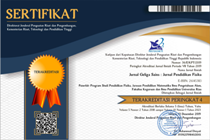The Development of Mobile Augmented Reality-Based Science Learning Media on Earth Layer Materials and Disasters in Class VII Junior High School
Abstract
Keywords
Full Text:
PDFReferences
Aminrais, S. J. & Bambang, S. (2014). Uji Validitas Konstruk pada Instrumen Ryff’s Psychological Well-Being 42 Version dengan Metode Confirmatory Factor Analysis (Cfa). Prosiding Koferensi Ilmiah Tahunan Himpunan Evaluasi Pendidikan Indonesia (HEPI). 18-20. September 2014. HEPI UKD Bali. Bali.
Bakri, F., Ambarwulan, D., & Muliyati, D. (2018). Pengembangan Buku Pembelajaran yang Dilengkapi Augmented reality pada Pokok Bahasan Gelombang Bunyi dan Optik. Jurnal Ilmiah Penelitian dan Pembelajaran Fisika, 4(2), 46-56.
Dünser, A., Walker, L., Horner, H., & Bentall, D. (2012). Creating Interactive Physics Education Books with Augmented Reality. Proceedings of the 24th Australian Computer-Human Interaction Conference.
Ghiffary, M. A. (2019). Keefektifan Game Kuis TTS Pintar sebagai Media Pembelajaran Mata Pembelajaran IPA Terpadu di SMP Islam Cahaya Insani Semarang. Skripsi, Fakultas Ilmu Pendidikan Universitas Negeri Semarang.
Hendriyani, Y., Effendi, H., Novaliendry, D., & Effendi, H. (2019). Augmented reality sebagai Media Pembelajaran Inovatif di Era Revolusi Industri 4.0. Jurnal Teknologi Informasi dan Pendidikan 12(3), 62-67.
Ivanova, M. & Ivanov, G. (2011). Enhancement of Learning and Teaching in Computer Graphics Through Marker Augmented reality Technology. International Journal on New Computer Architectures and Their Applications 1(1): 176-184.
Karimatussalamah, S. (2018). Pengembangan Modul IPA untuk Materi Mendeskripsikan Struktur Bumi Siswa Kelas V. Skripsi, Fakultas Keguruan dan Ilmu Pendidikan Universitas Nusantara PGRI Kediri.
Lee, K. (2012). Augmented reality in Education and Training. Research Practice Improve Learning, 56(2), 13-21.
Mustaqim, I. (2016). Pemanfaatan Augmented reality sebagai Media Pembelajaran. JPTK FT UNY, 13(2), 174-183.
Nurhasanah, S. (2018). Pengembangan Media Pembelajaran Floods and Ground Water Infiltration Phenomena (FLOGWIP) untuk Meningkatkan Penguasaan Konsep Materi Lapisan Bumi dan Bencana pada Siswa Kelas VII SMP/MTs. Skripsi, Fakultas Keguruan dan Ilmu Pendidikan Universitas Muhammadiah Malang.
Persefoni, K., & Tsinakos, A. (2015). Use of Augmented reality in terms of creativity in School learning. ICEC’15, September 29, 2015, Trondheim, Norway.
Putra, I. E. (2013). Teknologi Media Pembelajaran Sejarah Melalui Pemanfaatan Multimedia Animasi Interaktif. Jurnal TEKNOIF, 1(2), 20-25.
Saputro, R. E. & Saputra, D. I. S. (2014). Pengembangan Media Pembelajaran Mengenal Organ Pencernaan Manusia Menggunkan Teknologi Augmented reality. Jurnal Buana Informatika, 6(2), 153-162.
Sari, E. V., Yurnetti, & Hamdi. (2018). Pengaruh Pemberian Spelling Puzzle dengan Model Problem Bade Learning terhadap Pencapaian Kompetensi Siswa IPA Kelas VII Materi Pemanasan Global dan Lapisan Bumi SMP Negeri 12 Padang. Pillar of Physics Education, 11(3), 9-16.
Sugiyono. (2015). Metode Penelitian Pendidikan; Pendekatan Kuantitatif, Kualitatif dan R&D. Cetakan ke-19. Bandung: Alfabeta.
Suryaningsih, A. (2019). Gagasan Pengembangan Augmented Reality pada Buku Bacaan sebagai Upaya Meningkatkan Minat Baca Siswa (Adaptasi Percepatan Literasi dari Korea Selatan). Jurnal Ide Guru, 4(1), 35-42.
Tegeh, I. M., Jampel, I. N., & Pudjawan, K. (2015). Pengembangan Buku Ajar Model Penelitian Pengembangan dengan Model ADDIE. Seminar Nasional dan Riset Inovatif 3: 208-216. Nov. 2015.
Wahyudi, A. K. (2014). ARca, Pengembangan Buku Interaktif Berbasis Augmented reality dengan Smartphone Android. JNTETI, 3(2), 96-102.
DOI: http://dx.doi.org/10.31258/jgs.9.1.60-69
Refbacks
- There are currently no refbacks.
Copyright (c) 2021 Miftahul Farhani Isty, M. Nor, Muhammad Sahal

This work is licensed under a Creative Commons Attribution 4.0 International License.
Jurnal ini terdaftar dan terindeks pada:
- Crossref
- Google Scholar
- Crossref
- Garuda
- Sinta
- Researchgate
- Dimensions
- Base
- Scilit
- OneSearch
- Road
- CiteFactor
- ResearchBib
- WorldCat



















